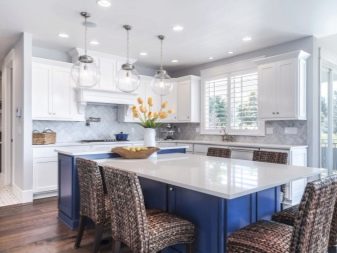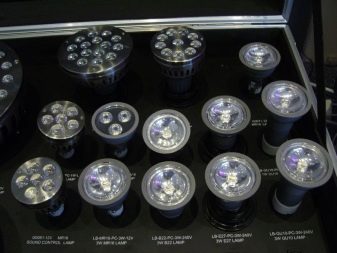False ceiling lamps: how to choose, location examples
Nowadays, a false ceiling has become quite popular, the appearance of which fits perfectly into almost any interior. With the proliferation of this type of ceilings, a huge selection of various lighting fixtures appeared on the market, which would be perfectly suited to integrate them into the interceiling space. For each of these lighting fixtures you need to choose the right light bulb, you can easily do this by learning more about each type.
Types and characteristics of lamps
Incandescent lamp - the worst option of all, since these products have a very high power consumption. The light from them propagates worse than from analogs, and, therefore, a lamp with such a light bulb will not fully perform its functions. In addition, they are very hot in the process. The power of the incandescent lamp has a range from 25 to 1000 W; however, in a living environment, products with a power not exceeding 150 W are used. Average service life fluctuates around 1500 hours.
Halogen lamps are an economical option, in good conditions they can work for quite a long time (about 4 thousand hours), such a lamp consumes less electricity than an incandescent lamp. Halogen bulbs are not sensitive to moisture.
Lamps used in suspended ceiling luminaires are available today in several varieties.
- Energy saving lamp heats up much less than incandescent lamp. These lamps are produced with different shades of white light: from warm for residential to cold, used on the streets. Such lamps consume 2 times less electricity than previous analogues. Service life - up to 10 thousand hours. Minor number of cons:
- is sensitive to moisture, so the room where it is used must be relatively dry;
- calculated on a certain number of inclusions;
- may be harmful to health, as mercury is inside the case.
- LED lamp - the most suitable type for a false ceiling. Such lamps have a very long lifespan (about 40 thousand hours), have a power much less than all other options, and, therefore, are very economical. They allow to disperse the most light, which is pleasing to the eye.Also, LED lamps are very environmentally friendly and absolutely safe for health.
How to place?
When installing luminaires (and lamps, respectively), one should think not only about their beauty, appearance and conformity to the interior, but also about the main functions and tasks. The main function of lamps and lamps built into them is the lighting of the room.
The light must be properly distributed, to be of high quality and as efficient as possible.
Not only the comfort of being in a room, but also the state of human health depends on proper lighting. Light can both positively and negatively affect the vision, psychological state of a person and his health in general, therefore When choosing the location of lighting devices, you should use certain rules.
- The distance from the wall to the nearest light fixture should be about 25 centimeters.
- The minimum distance from the lamp to the seam PVC film is 15-20 centimeters.
- The lamp must be positioned correctly, providing the desired intensity of light. The work area should be well lit. In the recreation area, the light should be diffused and relaxing.
- One lamp illuminates about two square meters of space.
- The desirable arrangement is a symmetrical arrangement of the lamps, which will allow the most efficient use of all the light.
Consider the examples of the placement of light sources in different areas of the apartment.
- Kitchen. In this case, in addition to the use of point lighting, it is possible to use several hanging lamps, which can be placed near the center of the room and above the kitchen table. On the remaining perimeter can be positioned spotlights, mounting them in a zigzag manner.
- Corridor. Here the location of the lamps depends entirely on the type of room. If the corridor is long and narrow, then you need to arrange the lamps parallel to the wall. If the corridor is wide but short, the lighting devices can be arranged in the form of a square, symmetrically to each other.
- Bathroom. In this case, you need to arrange special waterproof lamps with lamps diamond or square around the perimeter.
- Living room. This is the place where you can place the light as you please, following the above rules. That is, you can make up some kind of figure, position the hanging lamp in the center,and on the sides of it symmetrically mount sources of point light. To complete the picture can properly selected wall sconces.
- Children's. In the case of this room, the lighting must be approached very responsibly, because the developing body of the child is very sensitive to all the little things around him. In the nursery, it is important to arrange the lamps so that everything is lit equally well. The main areas that require special attention in this room are the area of the desk and rest. The first one should have good lighting that could not spoil the child’s vision, and the second one should be positioned so that the baby can rest.
- Bedroom. The room in which the lighting should help relax and tune in to rest. It is recommended to place the lamps in the form of a circle, an oval or in a checkerboard pattern. Lighting can also be supplemented with several bedside sconces.
How to replace?
Each light bulb may burn out sooner or later, this cannot be avoided, so it is important to be able to correctly replace it with a new one. Before starting the replacement, you should determine the way in which this lamp was installed, and then choose the best option for removal and installation.
- The easiest way is to mount the light bulb along the thread.If the lamps in your luminaire are installed this way, then it will be absolutely easy to change them. You just need to unscrew the old light bulb along the thread and install a new one in its place in the same way.
- Also, the bulb can be fixed with special projections turned at a right angle to the ceiling. Such a lamp must be removed for these special projections.
- If the bulb holds on to the lamp with the help of two rods or pins, it is sufficient to simply remove the old one, exert some effort, and then insert the new one in the same position.
With any type of lamp during the replacement, it is necessary to completely turn off the current supply to the lamp with which you intend to work, and even better, if there is such an opportunity, turn off the electricity completely in the whole apartment.
When working with a lamp, it is necessary to stand on a stable object (chair, stepladder, etc.) in order to get closer to the light bulb.
Throughout all the work, you need to be careful and careful, do not exert excessive effort to avoid being injured by broken glass fragments. The work should be carried out slowly, at a normal pace for you.
Light fixtures
Now consider the lamps for the suspended ceiling. They are of two types: point and modular. Modular types are less popular and are more suitable for some kind of work space. A modular lamp usually consists of a special box in which several lamps are built. From above, the box is closed with a plastic transparent lid, the light from the luminaire is directed in a straight line and illuminates only a certain space.
A distinctive feature of spotlights is the ability to adjust the intensity of light and its direction. There are a huge number of spotlights for this type of ceiling, but you can pick up absolutely anyone based on your tastes and preferences.
The luminaire can be made of almost any material, it can be of any shape, color, etc. But before choosing a suitable lighting device, you need to understand a little about its varieties and features, and also make sure that that type of lamp fits which you have chosen.
Types of lamps on the location of the ceiling:
- invoices (completely located on the surface of the ceiling,the lamp is located in a special decorative case));
- recessed (the main part is under the ceiling, and from the outside only its outer part is visible).
Types of lamps by type of design:
- non-rotating - the light goes in one direction;
- rotary - the direction of light can be adjusted.
The main components of the lamp for a suspended ceiling:
- housing with integrated chuck;
- light bulb;
- top cover;
- holder that fixes the lamp in the ceiling.
Summing up, it is safe to say that for lamps located in a false ceiling, the LED bulb, which has a huge number of advantages, is best suited. However, in any case, the choice is yours.
To learn how to install and connect the LED lights in the suspended ceiling, see the video below.
























































